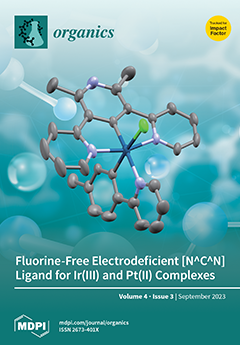Cyclometallated iridium(III) and platinum(II) complexes are intensely used in optoelectronics for their photophysical properties and ability to convert excitons from singlet to triplet state, thus improving the device efficiency. In this contribution, we report the multi-steps synthesis of an electrodeficient dipyridylbenzene-like terdentate ligand
[...] Read more.
Cyclometallated iridium(III) and platinum(II) complexes are intensely used in optoelectronics for their photophysical properties and ability to convert excitons from singlet to triplet state, thus improving the device efficiency. In this contribution, we report the multi-steps synthesis of an electrodeficient dipyridylbenzene-like terdentate ligand [N^C^N], namely 2′,6′-dimethyl-2,3′:5′,2″-terpyridine (
6), with 18% overall yield. Compound
6 has been employed to synthesize two phosphorescent complexes of platinum(II) and iridium(III), namely compounds
7 and
8, respectively. Both complexes have been characterized by NMR and high resolution mass spectrometry, and demonstrate high luminescence quantum yields in a deaerated solution at room temperature, with 18% and 61% for
7 and
8, respectively. If the iridium(III) complex displays similar emission properties to [Ir(dpyx)(ppy)Cl] (dpyx = 3,5-dimethyl-2,6-dipyridylbenzene and ppy = 2- phenylpyridine), the platinum(II) derivative, with λ
em = 470 nm, is a rare example of a fluorine atom-free blue emitting [N^C^N]PtCl complex.
Full article





